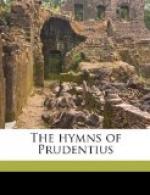meaning a familiar figure. The gradual transition from paganism
to Christianity is curiously illustrated by the fact that in several
of the Catacomb bas-reliefs and paintings the Good Shepherd holds in
His outstretched hand a Pan’s pipe. See Maitland’s Church in the
Catacombs, p. 315, for a woodcut of the Good Shepherd with a lamb
over His shoulders, two sheep at His feet, a palm tree (or poplar)
on either side, and a Pan’s pipe in His right hand; and also the
frontispiece for a reproduction from the Cemetery of St. Peter and
St. Marcellinus.
IX
1 This hymn, which first introduced into sacred
song the trochaic
metre familiar in Greek
Tragedy and the Latin adaptations of it,
supplies the Moz.
Brev. with some stanzas for use during Holy Week.
The lines selected are
22-24, 1-21.
11 The use of the symbol O, (pronounced
here as a single
syllable), appears to
indicate that the names Omega and Omikron
came into use at a later
date than Prudentius’ time. In Rev. i. 8,
the best MSS. read ego
eimi to alpha kai to o.
33 The words vulnerum piamina are generally
supposed to refer to
the “gifts which
Moses commanded” to be offered by those healed
of
leprosy (Lev. xiv. 2).
If so, Prudentius’ language may imply that
the cure was not actually
complete until the offering of these gifts,
and is at variance with
St. Matthew, viii. 43, “and forthwith his
leprosy was cleansed.”
Probably, however, his idea is rather that
the gifts to the priest
formally marked the leper as a clean man.
71 Cf. note on iii. 199.
X
1 Parts of this hymn are used in the Moz.
Brev. in the Office of the
Dead, being ll. 1-16,
45-48, 57-68, 157-168.
The burial rites of the primitive Church were simple, and marked by an absence of the ostentatious expression of grief which the pagan peoples displayed. The general practice of cremation was rejected, partly owing to the new belief in the resurrection of the body, and partly from a desire to imitate the burial of the Lord. At Rome, during the first three centuries, the dead were laid in the Catacombs, in which Prudentius took conspicuous interest (see Translator’s Note), but after 338 A.D. this practice became less frequent, and was completely abandoned after 410 A.D. Elsewhere, from the earliest times, the Christians purchased special enclosures (areae), which were often attacked and rifled by angry mobs in the days of persecution. The body was frequently embalmed (cf. ll. 51, 52), swathed in white linen (l. 49), and placed in a coffin; vigils and hymns continued for three or four days, but hired mourners were forbidden (l. 113), and instead of the dirges




